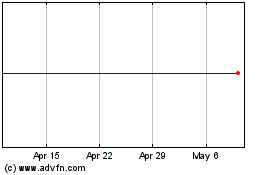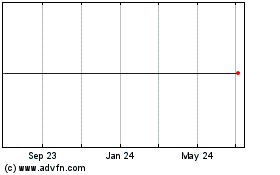Sharp rise in prices of some commodities gives companies
breathing space, improving cash flow and allowing payback of some
borrowings
By Rhiannon Hoyle in Sydney and Alex MacDonald in London
Global mining companies have pushed hard to ditch their debts:
They have sold pits, laid off workers and pruned expenses from
every part of their businesses. This year, an extra tailwind from
improving commodity prices is helping miners' repay borrowings more
quickly than expected.
The signs of improving balance sheets haven't come a moment too
soon for investors who have seen dividends cut recently as mining
companies have prioritized reducing their debt loads.
A decadelong China-led commodities price boom had encouraged
executives to build out networks of pits, railways and ports and
make costly acquisitions to grow. By the end of 2013, the world's
top five mining companies had nearly US$120 billion in net debt on
their books, roughly five times more than a decade earlier.
Concerns about miners' debt levels intensified earlier this
year, when Moody's Investors Service cut the credit ratings of
major companies including BHP Billiton and Rio Tinto. It even
downgraded the debt of Anglo American PLC to junk status.
But the sharp rise in the prices of some commodities this year
has given companies some breathing space. Iron ore is up 40% so far
this year, for example, while thermal-coal prices are up by
one-third. In turn, that has helped improve cash flow, allowing for
some debt reductions.
Mining stocks have rallied and the prices of credit-default
swaps, which act as insurance against a debt default, have tumbled.
Once-panicked investors are breathing a sigh of relief, although
most caution that these companies still have some way to go. BHP,
the world's No. 1 mining company by market value, is to report its
annual earnings on Tuesday and is expected to restate its focus on
reducing debt.
Anglo American said last month its net debt had fallen to 35.4%
of its equity -- a commonly used measure of company indebtedness --
from 37.7% at the end of 2015. Rio Tinto shaved its so-called
gearing ratio to 23% from 24% over the same period.
Anglo has been restructuring its business as it looks to shore
up its finances. It plans to sell more than half its operations to
focus on diamonds, platinum and copper.
Although the company reported a steep first-half loss a little
over two weeks ago, its net debt fell to $11.7 billion as of June
30 from $12.9 billion at the end of 2015, thanks mainly to
cost-cutting.
"Not only should Anglo American hit its year-end net debt target
[of less than $10 billion], but we believe it could also hit its
medium-term target of $6 billion in the next 18 months," Canaccord
Genuity said in a recent note.
BHP, too, has made strides in the past few years, although it
has faced unexpected costs linked to a dam failure at its Samarco
Mineração joint venture. That disaster, which killed 19 people and
polluted hundreds of kilometers of rivers in Brazil, has also hit
partner Vale SA, another of the world's big miners.
Analysts expect BHP to report a small rise in its net debt on
Tuesday, alongside what could be its worst net loss since the
company was formed through the merger of BHP Ltd. and Billiton PLC
in 2001. The company is expected to record an annual net loss of
roughly $5.8 billion.
Still, Credit Suisse forecasts that BHP could pare its net debt
to $19.1 billion by mid-2018, from $24.4 billion at the end of June
last year. UBS says it could be as low as $16.6 billion by
mid-2018.
Easing concerns over the mining company's finances are reflected
in the sliding cost of credit-default swaps on its debt. The cost
of protecting $10 million of BHP debt against nonpayment over a
five-year period was last week down to $124,000 annually from as
much as $252,000 in February, according to data group Markit.
There have been similar declines for BHP's peers. The cost of
insuring $10 million of Rio Tinto debt against default fell to
$136,000 last week, from as high as $279,000 in February. The same
credit-default swaps for Glencore PLC -- which aims to cut its net
debt by as much as one-third this year -- have tumbled from more
than $1 million early this year to roughly $250,000 now.
"There is no question that the market thinks the debt issues are
not an issue at all" for Glencore, said Nik Stanojevic, equity
analyst at Brewin Dolphin, citing the magnitude of the drop in the
cost of those swaps. Brewin Dolphin, a private wealth firm, owns
Glencore shares.
Still, some investors say they hope mining companies keep debt
reduction a priority.
The improvement in commodity markets has taken the issue "off
the agenda, but if China has another hiccup and prices come off
then people will be worried again," said Andrew Lapping, deputy
chief investment officer at South Africa-based Allan Gray.
Write to Rhiannon Hoyle at rhiannon.hoyle@wsj.com and Alex
MacDonald at alex.macdonald@wsj.com
(END) Dow Jones Newswires
August 16, 2016 02:48 ET (06:48 GMT)
Copyright (c) 2016 Dow Jones & Company, Inc.
BHP (NYSE:BBL)
Historical Stock Chart
From Mar 2024 to Apr 2024

BHP (NYSE:BBL)
Historical Stock Chart
From Apr 2023 to Apr 2024
